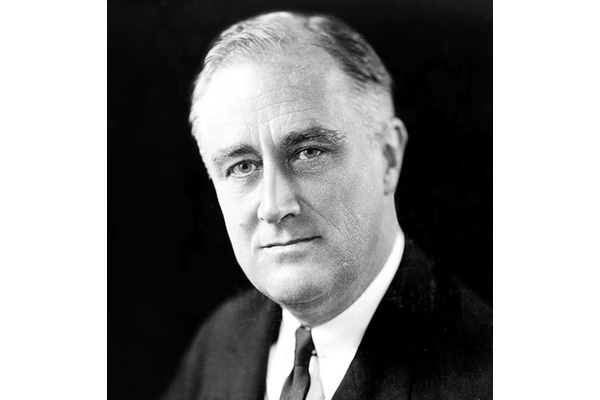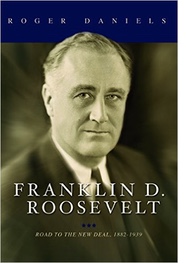Surprises in a New Account of FDR

Why is my biography of FDR different from all other such biographies? It does not attempt to replace the volumes produced by Frank Freidel between 1952 and 1990. There are many other useful biographies. My two volumes were designed to explore how Roosevelt managed to govern the nation effectively through the two greatest crises of its modern history despite an increasingly conservative and sometimes hostile Congress. In the process he transformed and modernized the federal government and changed, fundamentally, its relationships, not only with states and cities, but also with its inhabitants. My remarks here are largely restricted to my first volume. I hope to present a parallel effort after the second volumes appear sometime next year.
 My
most important sources are Roosevelt himself, and I quote, to an
unfashionable extent, not only his speeches, but also from his
thousand plus press conferences and numerous informal ones as
reported in the press, public documents of all kinds, as well as
personal letters. In addition to FDR's own words I utilize
extensively the testimony of a few key witnesses, most frequently Sam
Rosenman, and in the second volume the diary kept by one of his
secretaries, Bill Hassett, and the notes of his wartime cardiologist,
Howard
Bruenn.
My
most important sources are Roosevelt himself, and I quote, to an
unfashionable extent, not only his speeches, but also from his
thousand plus press conferences and numerous informal ones as
reported in the press, public documents of all kinds, as well as
personal letters. In addition to FDR's own words I utilize
extensively the testimony of a few key witnesses, most frequently Sam
Rosenman, and in the second volume the diary kept by one of his
secretaries, Bill Hassett, and the notes of his wartime cardiologist,
Howard
Bruenn.
Readers who know the work of what I style the founding generation of New Deal scholars – Freidel, James M. Burns, Arthur Schlesinger, Jr., and William Leuchtenburg – will be familiar with my overall interpretation. Their first major works focused my attention and I owe much to each of them, but I depart from all three on certain key matters. I argue that despite the spectacular Hundred Days that began Roosevelt's presidency, the real New Deal did not start until the creation of the CWA in November 1933 initiated massive work relief programs.
In addition it seems to me that the founders were overly impressed by FDR's mediocre grades at Harvard – he loved his life there and wasn't concerned with grades – and generally underrate his intellectual ability as opposed to his flair for politics and mastery of preparation and details. They all but ignore what I call his post-graduate education. As New York's governor he took on leftist economist Paul Douglas to get him up to speed on unemployment, and brought in a series of other intellectuals to brief him on issues such as electric power regulation. He continued that education while in the White House, most notably after the onset of the Roosevelt Recession of 1937-38 when presidential assistant Laughlin Currie and others converted him to closet Keynesianism, which he never acknowledged. Few successful men in their late 40s take on such discipline.
On three important topics in my volumes, I deviate from the standard interpretations. I develop a narrative describing the transformation of FDR's views on race. If Governor Roosevelt ever did or said anything of significance about New York's 400,000 black citizens, it remains a secret. But from the 1932 Democratic convention, when Roosevelt was forced to acknowledge prematurely his intention to shelve the two-thirds rule that was a key to southern power in the Democratic party, I relate and analyze how Roosevelt's position on race evolved as he moved, slowly, from non-action, to excuses for inaction, to token actions, and, finally, to serious but labored steps toward moderating Jim Crow as well as other discriminatory practices and statutes that limited the lives of all Americans of color. Similarly, I show that, although there was never a New Deal for immigration, his actions during World War II were a turning point in the history of American immigration regulation.
With some of the prevailing interpretations of Roosevelt's policies by later generations of historians of the Roosevelt Era, I have some fundamental differences. Focusing on the years after 1936 they tell a woeful tale of an increasingly ineffective leader, his characteristic prudence blunted by overconfidence in the wake of an electoral tsunami which seemed to be drowning the Republican Party, they focus on the thwarted attempt to pack the Supreme Court, the so called attempt to "purge" conservative office holders from the Democratic Party, and his deliberate deceleration of deficit spending which brought about the brief, severe Roosevelt Recession of 1937-8. These three blunders, they argue, marked the end of the New Deal and of reform.
This now largely prevailing view, it seems to me, distorts our understanding of those events and their consequences. In the Court fight Roosevelt clearly won the war. Chief Justice Charles Evans Hughes seems to have secretly brought about the famous "switch in time which saved nine" that became apparent when the Court surprisingly failed to reject key pieces of New Deal legislation, the Social Security and the Labor Relations Acts in the winter and spring of 1937. Roosevelt, his usual good sense deserting him, persisted, well into the summer, in insisting that Congress pass the bill, drafted by his feckless first attorney general, enabling him to appoint additional justices. He ignored good advice from supporters, most strikingly from Jimmy Byrnes, who urged him to stop running to catch a train he had already caught.
Later that summer and fall he signaled a reduction in spending which helped trigger the Roosevelt Recession of 1937-8, still the steepest easily measureable economic decline in American economic history. His relative rapid legislative response in the spring was most effective and the positive economic trends that had set in during 1934 were reinstated. Even friendly historians have undervalued the return of what seemed to be a kind of prosperity even before defense and war spending produced a general level of prosperity and well-being never before experienced in industrial America. Roosevelt's relative success, beginning in April 1938, in turning the slumping economy around, should be better appreciated now that we have witnessed the ineptitude and timidity of the Federal Reserve Bank and the Obama administration in the painfully slow reversal of our most recent economic slump.
My deviation from the standard treatments of Roosevelt's foreign policies are less striking. While celebrating the reversal in hemispheric relations signified by the Good Neighbor policy, I do point to its dark side, the toleration and support of brutal regimes in the Caribbean region. Unlike some historians, I argue that Roosevelt always, after the shipboard encounter with his chief while returning from Versailles, regarded himself as a Wilsonian, and his seeming apostasy as he sought the presidency and during most of his first two terms, was a matter of political expediency. not a change of what had become a basic belief.
As late as his famous "I hate war" speech at Chautauqua Institute in August 1936 Roosevelt seemed in tune with the generally isolationist national mood. But increasingly concerned by the rise of Hitler, his "quarantine speech" in Chicago fourteen months later marked the start of a masterful campaign to change the mindset of America. His continuing public advocacy changed so many minds that clear majorities supported his growing defense programs even in peacetime.
I find a basic consistency in Roosevelt's purposes despite tactical shifts and seeming shifts and reversals in basic philosophy. Above all, I see him as future oriented. Last month, as I watched, on television, the arrival of China`s President Xi Jinping and his entourage in Seattle hustle to visit our industrial oligarchs at Boeing and Microsoft, I remembered what Roosevelt wrote to Dickie Mountbatten seventy-two years ago about how “very useful it will be twenty-five or fifty years hence” to have “the four hundred and twenty five million Chinese” on our side.
I hope to be able to explicate further on these matters after the publication of my second volume early next year.